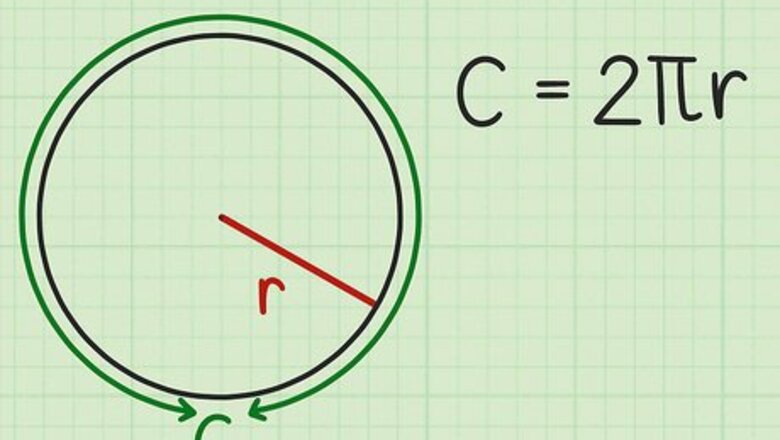
views
X
Research source
The easiest way to find the radius is by dividing the diameter in half. If you don’t know the diameter but you know other measurements, such as the circle’s circumference (
C
=
2
π
r
{\displaystyle C=2\pi r}
) or area (
A
=
π
r
2
{\displaystyle A=\pi r^{2}}
), you can still find the radius by using the formulas and isolating the
r
{\displaystyle r}
variable.
Using the Circumference
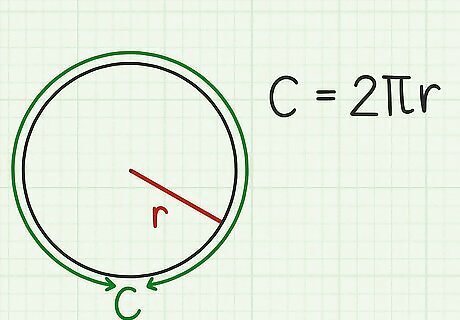
Write down the circumference formula. The formula is C = 2 π r {\displaystyle C=2\pi r} C=2\pi r, where C {\displaystyle C} C equals the circle’s circumference, and r {\displaystyle r} r equals its radii The symbol π {\displaystyle \pi } \pi ("pi") is a special number, roughly equal to 3.14. You can either use that estimate (3.14) in calculations, or use the π {\displaystyle \pi } \pi symbol on a calculator.

Solve for r. Use algebra to change the circumference formula until r (radius) is alone on one side of the equation: Example C = 2 π r {\displaystyle C=2\pi r} C=2\pi r C 2 π = 2 π r 2 π {\displaystyle {\frac {C}{2\pi }}={\frac {2\pi r}{2\pi }}} {\frac {C}{2\pi }}={\frac {2\pi r}{2\pi }} C 2 π = r {\displaystyle {\frac {C}{2\pi }}=r} {\frac {C}{2\pi }}=r r = C 2 π {\displaystyle r={\frac {C}{2\pi }}} r={\frac {C}{2\pi }}
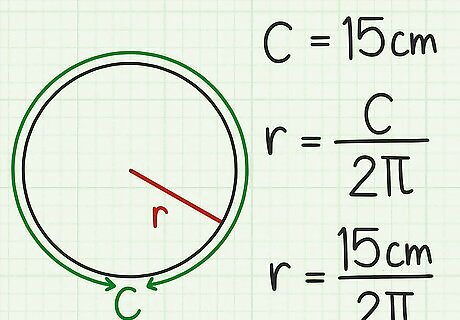
Plug the circumference into the formula. Whenever a math problem tells you the circumference C of a circle, you can use this equation to find the radius r. Replace C in the equation with the circumference of the circle in your problem: ExampleIf the circumference is 15 centimeters, your formula will look like this: r = 15 2 π {\displaystyle r={\frac {15}{2\pi }}} r={\frac {15}{2\pi }} centimeters
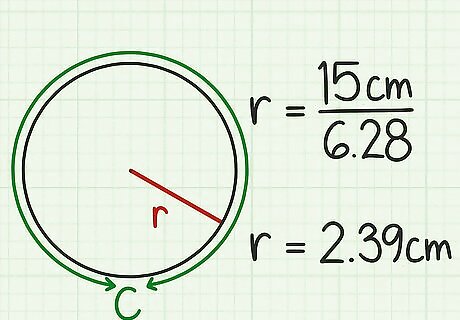
Round to a decimal answer. Enter your result in a calculator with the π {\displaystyle \pi } \pi button and round the result. If you don't have a calculator, calculate it by hand, using 3.14 as a close estimate for π {\displaystyle \pi } \pi . Example r = 15 2 π = {\displaystyle r={\frac {15}{2\pi }}=} r={\frac {15}{2\pi }}= about 7.5 2 ∗ 3.14 = {\displaystyle {\frac {7.5}{2*3.14}}=} {\frac {7.5}{2*3.14}}= approximately 2.39 centimeters
Using the Area
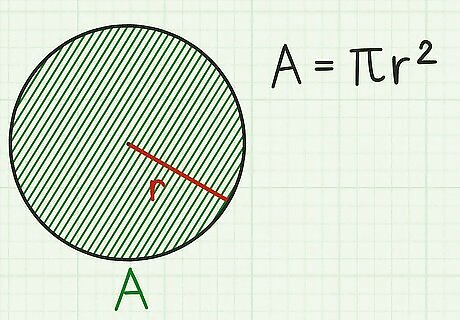
Set up the formula for the area of a circle. The formula is A = π r 2 {\displaystyle A=\pi r^{2}} A=\pi r^{{2}}, where A {\displaystyle A} A equals the area of the circle, and r {\displaystyle r} r equals the radius.

Solve for the radius. Use algebra to get the radius r alone on one side of the equation: ExampleDivide both sides by π {\displaystyle \pi } \pi : A = π r 2 {\displaystyle A=\pi r^{2}} A=\pi r^{{2}} A π = r 2 {\displaystyle {\frac {A}{\pi }}=r^{2}} {\frac {A}{\pi }}=r^{{2}}Take the square root of both sides: A π = r {\displaystyle {\sqrt {\frac {A}{\pi }}}=r} {\sqrt {{\frac {A}{\pi }}}}=r r = A π {\displaystyle r={\sqrt {\frac {A}{\pi }}}} r={\sqrt {{\frac {A}{\pi }}}}
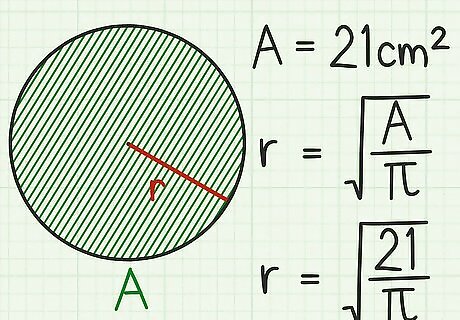
Plug the area into the formula. Use this formula to find the radius when the problem tells you the area of the circle. Substitute the area of the circle for the variable A {\displaystyle A} A. ExampleIf the area of the circle is 21 square centimeters, the formula will look like this: r = 21 π {\displaystyle r={\sqrt {\frac {21}{\pi }}}} r={\sqrt {{\frac {21}{\pi }}}}
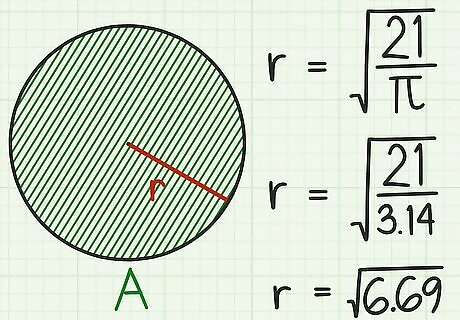
Divide the area by π {\displaystyle \pi } \pi . Begin solving the problem by simplifying the portion under the square root ( A π ) {\displaystyle {\frac {A}{\pi }})} {\frac {A}{\pi }}). Use a calculator with a π {\displaystyle \pi } \pi key if possible. If you don't have a calculator, use 3.14 as an estimate for π {\displaystyle \pi } \pi . ExampleIf using 3.14 for π {\displaystyle \pi } \pi , you would calculate: r = 21 3.14 {\displaystyle r={\sqrt {\frac {21}{3.14}}}} r={\sqrt {{\frac {21}{3.14}}}} r = 6.69 {\displaystyle r={\sqrt {6.69}}} r={\sqrt {6.69}}If your calculator allows you to enter the whole formula on one line, that will give you a more accurate answer.
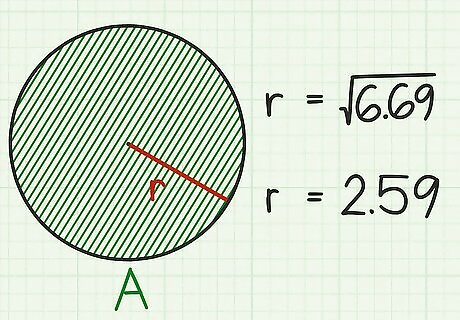
Take the square root. You will likely need a calculator to do this, because the number will be a decimal. This value will give you the radius of the circle. Example r = 6.69 = 2.59 {\displaystyle r={\sqrt {6.69}}=2.59} r={\sqrt {6.69}}=2.59. So, the radius of a circle with an area of 21 square centimeters is about 2.59 centimeters.Areas always use square units (like square centimeters), but the radius always uses units of length (like centimeters). If you keep track of units in this problem, you'll notice that c m 2 = c m {\displaystyle {\sqrt {cm^{2}}}=cm} {\sqrt {cm^{{2}}}}=cm.
Using the Diameter
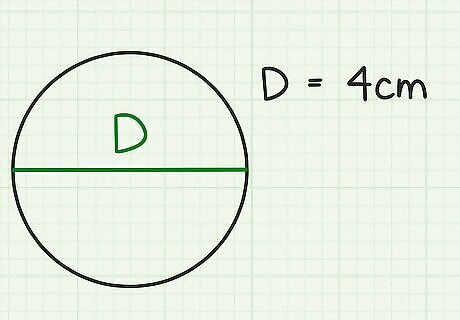
Check the problem for a diameter. If the problem tells you the diameter of the circle, it's easy to find the radius. If you are working with an actual circle, measure the diameter by placing a ruler so its edge passes straight through the circle's center, touching the circle on both sides. If you're not sure where the circle center is, put the ruler down across your best guess. Hold the zero mark of the ruler steady against the circle, and slowly move the other end back and forth around the circle's edge. The highest measurement you can find is the diameter. For example, you might have a circle with a diameter of 4 centimeters.
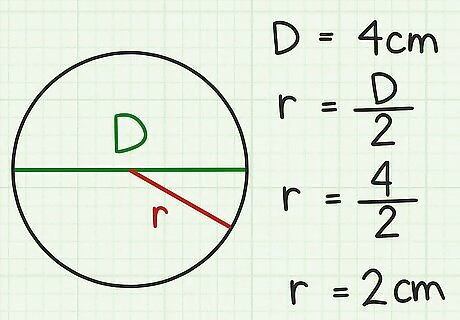
Divide the diameter by two. A circle's radius is always half the length of its diameter. For example, if the diameter is 4 cm, the radius equals 4 cm ÷ 2 = 2 cm. In math formulas, the radius is r and the diameter is d. You might see this step in your textbook as r = d 2 {\displaystyle r={\frac {d}{2}}} r={\frac {d}{2}}.
Using the Area and Central Angle of a Sector
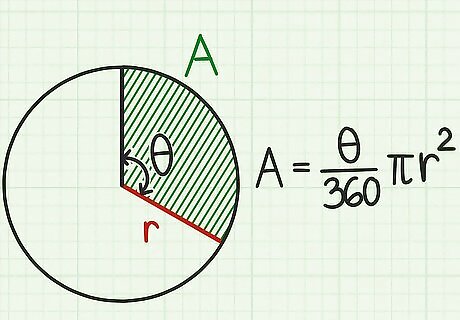
Set up the formula for the area of a sector. The formula is A s e c t o r = θ 360 ( π ) ( r 2 ) {\displaystyle A_{sector}={\frac {\theta }{360}}(\pi )(r^{2})} A_{{sector}}={\frac {\theta }{360}}(\pi )(r^{{2}}), where A s e c t o r {\displaystyle A_{sector}} A_{{sector}} equals the area of the sector, θ {\displaystyle \theta } \theta equals the central angle of the sector in degrees, and r {\displaystyle r} r equals the radius of the circle.
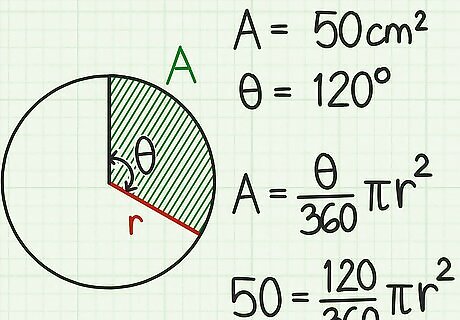
Plug the sector’s area and central angle into the formula. This information should be given to you. Make sure you have the area of the sector, not the area for the circle. Substitute the area for the variable A s e c t o r {\displaystyle A_{sector}} A_{{sector}} and the angle for the variable θ {\displaystyle \theta } \theta . ExampleIf the area of the sector is 50 square centimeters, and the central angle is 120 degrees, you would set up the formula like this: 50 = 120 360 ( π ) ( r 2 ) {\displaystyle 50={\frac {120}{360}}(\pi )(r^{2})} 50={\frac {120}{360}}(\pi )(r^{{2}}).
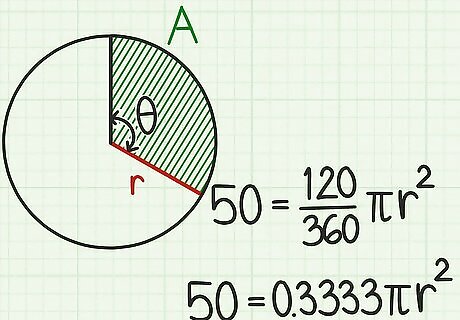
Divide the central angle by 360. This will tell you what fraction of the entire circle the sector represents. Example 120 360 = 1 3 {\displaystyle {\frac {120}{360}}={\frac {1}{3}}} {\frac {120}{360}}={\frac {1}{3}}. This means that the sector is 1 3 {\displaystyle {\frac {1}{3}}} {\frac {1}{3}} of the circle.Your equation should now look like this: 50 = 1 3 ( π ) ( r 2 ) {\displaystyle 50={\frac {1}{3}}(\pi )(r^{2})} 50={\frac {1}{3}}(\pi )(r^{{2}})
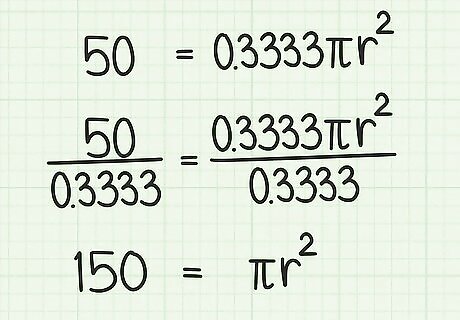
Isolate ( π ) ( r 2 ) {\displaystyle (\pi )(r^{2})} (\pi )(r^{{2}}). To do this, divide both sides of the equation by the fraction or decimal you just calculated. Example 50 = 1 3 ( π ) ( r 2 ) {\displaystyle 50={\frac {1}{3}}(\pi )(r^{2})} 50={\frac {1}{3}}(\pi )(r^{{2}}) 50 1 3 = 1 3 ( π ) ( r 2 ) 1 3 {\displaystyle {\frac {50}{\frac {1}{3}}}={\frac {{\frac {1}{3}}(\pi )(r^{2})}{\frac {1}{3}}}} {\frac {50}{{\frac {1}{3}}}}={\frac {{\frac {1}{3}}(\pi )(r^{{2}})}{{\frac {1}{3}}}} 150 = ( π ) ( r 2 ) {\displaystyle 150=(\pi )(r^{2})} 150=(\pi )(r^{{2}})
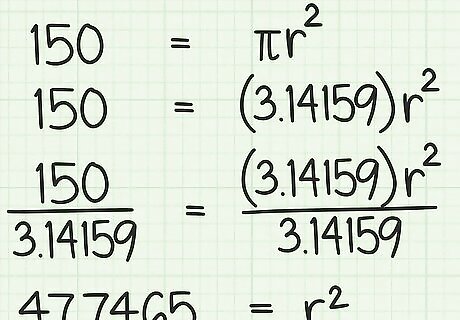
Divide both sides of the equation by π {\displaystyle \pi } \pi . This will isolate the r {\displaystyle r} r variable. For a more precise result, use a calculator. You can also round π {\displaystyle \pi } \pi to 3.14. Example 150 = ( π ) ( r 2 ) {\displaystyle 150=(\pi )(r^{2})} 150=(\pi )(r^{{2}}) 150 π = ( π ) ( r 2 ) π {\displaystyle {\frac {150}{\pi }}={\frac {(\pi )(r^{2})}{\pi }}} {\frac {150}{\pi }}={\frac {(\pi )(r^{{2}})}{\pi }} 47.7 = r 2 {\displaystyle 47.7=r^{2}} 47.7=r^{{2}}
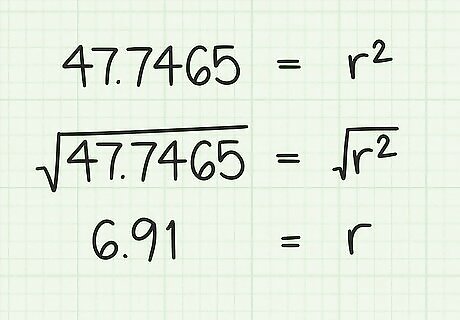
Take the square root of both sides. This will give you the radius of the circle. Example 47.7 = r 2 {\displaystyle 47.7=r^{2}} 47.7=r^{{2}} 47.7 = r 2 {\displaystyle {\sqrt {47.7}}={\sqrt {r^{2}}}} {\sqrt {47.7}}={\sqrt {r^{{2}}}} 6.91 = r {\displaystyle 6.91=r} 6.91=rSo, the radius of the circle is about 6.91 centimeters.


















Comments
0 comment